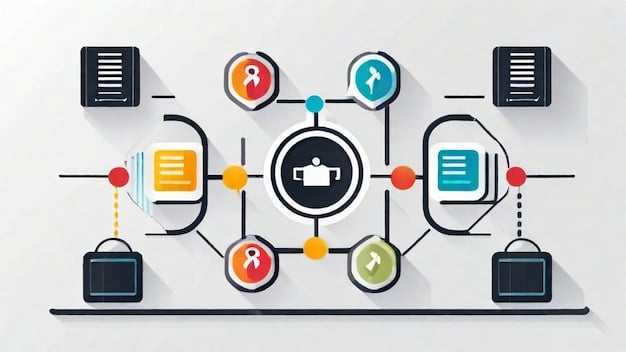Data Privacy Compliance for US Startups: CCPA 2.0 Prep in 2025

Data Privacy Compliance for US Startups: How to Prepare for the California Consumer Privacy Act (CCPA) 2.0 in 2025 involves understanding the updated regulations, implementing necessary security measures, and ensuring transparency with consumer data handling practices. Preparing now can help startups avoid costly penalties and maintain customer trust.
Navigating the complex landscape of data privacy can be daunting for US startups, especially with the ever-evolving regulations. One of the most significant pieces of legislation to keep on your radar is the California Consumer Privacy Act (CCPA) 2.0, set to take full effect in 2025. Understanding and preparing for Data Privacy Compliance for US Startups: How to Prepare for the California Consumer Privacy Act (CCPA) 2.0 in 2025 is not just a legal requirement; it’s a crucial step in building trust with your customers and ensuring the long-term success of your business.
This article provides a comprehensive guide to help you understand and prepare for these changes, ensuring your startup is ready for the future of data privacy.
Understanding the California Consumer Privacy Act (CCPA) 2.0
The California Consumer Privacy Act (CCPA) 2.0, officially known as the California Privacy Rights Act (CPRA), builds upon the foundation of the original CCPA. It introduces new rights for consumers and imposes stricter obligations on businesses that collect and process personal information.
Understanding these changes is crucial for startups to ensure they are compliant and avoid potential penalties.
Key Changes Introduced by CCPA 2.0
CCPA 2.0 brings several significant updates to the original legislation. These changes include new consumer rights, expanded definitions of personal information, and the establishment of a dedicated privacy enforcement agency.
- New Consumer Rights: Consumers now have the right to correct inaccurate personal information and limit the use of sensitive personal information.
- Expanded Definition of Personal Information: The definition of personal information has been broadened to include data such as precise geolocation, race, ethnicity, and religious beliefs.
- Establishment of the California Privacy Protection Agency (CPPA): The CPPA is responsible for enforcing the CCPA 2.0 and providing guidance to businesses on compliance.
These changes necessitate a comprehensive review of your data privacy practices to ensure they align with the new requirements. Failing to do so can result in substantial fines and reputational damage.

In this section, we’ve highlighted the core updates brought by CCPA 2.0. Grasping these changes is the first step toward achieving Data Privacy Compliance for US Startups: How to Prepare for the California Consumer Privacy Act (CCPA) 2.0 in 2025.
Assessing Your Startup’s Current Data Privacy Practices
Before you can prepare for CCPA 2.0, it’s essential to evaluate your startup’s current data privacy practices. This involves identifying the types of personal information you collect, how you use it, and with whom you share it.
A thorough assessment will help you pinpoint areas where you need to improve to meet the new requirements.
Conducting a Data Inventory
A data inventory is a comprehensive list of all the personal information your startup collects, stores, and processes. This inventory should include details such as the source of the data, the purpose for which it is collected, and the retention period.
Consider these key questions when conducting your data inventory:
- What types of personal information do we collect?
- Where does this information come from?
- How do we use this information?
- With whom do we share this information?
- How long do we retain this information?
Identifying Gaps in Compliance
Once you have completed your data inventory, compare your current practices with the requirements of CCPA 2.0. Identify any gaps in compliance and prioritize them based on the level of risk they pose to your startup.
Areas where you may find gaps include:
- Data collection practices
- Consumer rights management
- Data security measures
- Privacy policy transparency
By understanding where you fall short, you can create a targeted plan to address these deficiencies and ensure you are fully compliant with CCPA 2.0.

By performing a thorough assessment of your startup’s data privacy practices, you’ll be well-equipped to tackle Data Privacy Compliance for US Startups: How to Prepare for the California Consumer Privacy Act (CCPA) 2.0 in 2025 effectively. This groundwork prepares you for the necessary changes ahead.
Implementing Necessary Security Measures
CCPA 2.0 requires businesses to implement and maintain reasonable security measures to protect personal information from unauthorized access, use, or disclosure. This includes both technical and organizational safeguards.
Ensuring robust security is not only a legal requirement but also a way to build trust with your customers.
Technical Safeguards
Technical safeguards involve the use of technology to protect personal information. These measures can include encryption, access controls, and regular security assessments.
- Encryption: Encrypt sensitive personal information both in transit and at rest.
- Access Controls: Implement strict access controls to limit who can access personal information.
- Regular Security Assessments: Conduct regular security assessments to identify and address vulnerabilities.
Organizational Safeguards
Organizational safeguards involve policies and procedures that promote data privacy and security. These measures can include employee training, incident response plans, and vendor management.
- Employee Training: Provide regular training to employees on data privacy and security best practices.
- Incident Response Plans: Develop and maintain incident response plans to address data breaches and other security incidents.
- Vendor Management: Ensure that third-party vendors who have access to personal information also maintain adequate security measures.
These security implementations protect data and are vital in ensuring your startup achieves Data Privacy Compliance for US Startups: How to Prepare for the California Consumer Privacy Act (CCPA) 2.0 in 2025, reinforcing trust with your clientele.
Updating Your Privacy Policy
Your privacy policy is a public statement of how your startup collects, uses, and protects personal information. CCPA 2.0 requires that your privacy policy be clear, comprehensive, and easily accessible to consumers.
An updated privacy policy is key to transparency and compliance.
Transparency Requirements
CCPA 2.0 mandates that your privacy policy include specific information about consumer rights, the types of personal information you collect, and the purposes for which you use it.
Your privacy policy should clearly state:
- The categories of personal information you collect.
- The purposes for which you use this information.
- How consumers can exercise their rights under CCPA 2.0.
- The categories of third parties with whom you share personal information.
Accessibility and Clarity
Your privacy policy should be written in plain language that is easy for consumers to understand. It should also be prominently displayed on your website and other channels where you collect personal information.
Consider these tips for improving the accessibility and clarity of your privacy policy:
- Use clear and concise language.
- Avoid legal jargon and technical terms.
- Use headings and bullet points to organize information.
- Provide examples to illustrate your practices.
- Make it easy for consumers to contact you with questions.
By ensuring transparency and clarity in your privacy policy, you can build trust with consumers and demonstrate your commitment to data privacy and to Data Privacy Compliance for US Startups: How to Prepare for the California Consumer Privacy Act (CCPA) 2.0 in 2025.
Training Employees on Data Privacy Best Practices
Employee training is a critical component of data privacy compliance. Your employees need to understand their responsibilities under CCPA 2.0 and how to handle personal information in a secure and responsible manner.
Well-trained employees are your first line of defense against data breaches and privacy violations.
Developing a Training Program
Your training program should cover the key principles of CCPA 2.0, including consumer rights, data security, and privacy policy requirements. It should also be tailored to the specific roles and responsibilities of your employees.
Key topics to include in your training program:
- Overview of CCPA 2.0 and its requirements.
- Consumer rights and how to respond to consumer requests.
- Data security best practices.
- Privacy policy compliance.
- Incident response procedures.
Ongoing Education
Data privacy laws and best practices are constantly evolving, so it’s essential to provide ongoing education to your employees. This can include regular training sessions, newsletters, and updates on new developments in the field.
Tips for keeping your employees informed:
- Conduct regular training sessions.
- Share updates on data privacy laws and best practices.
- Provide access to resources and tools.
- Encourage employees to ask questions and share concerns.
By investing in employee training, you can foster a culture of data privacy within your startup and ensure that your employees are equipped to handle personal information responsibly, thus assisting Data Privacy Compliance for US Startups: How to Prepare for the California Consumer Privacy Act (CCPA) 2.0 in 2025.
Preparing for Consumer Rights Requests
CCPA 2.0 gives consumers several rights over their personal information, including the right to access, correct, and delete their data. Startups must be prepared to respond to these requests in a timely and efficient manner.
Managing consumer rights requests is a critical aspect of CCPA 2.0 compliance.
Establishing Procedures for Handling Requests
You should establish clear procedures for receiving, verifying, and responding to consumer rights requests. This includes designating a point of contact for handling requests, developing a verification process, and implementing a system for tracking requests.
Key steps in handling consumer rights requests:
- Receive the request.
- Verify the identity of the consumer.
- Process the request.
- Respond to the consumer.
- Document the request and response.
Ensuring Timely Responses
CCPA 2.0 requires businesses to respond to consumer rights requests within a specific timeframe. Failure to do so can result in penalties. Startups must monitor and act on consumer requests to meet these deadlines.
Meeting these obligations showcases a commitment to consumer privacy and to Data Privacy Compliance for US Startups: How to Prepare for the California Consumer Privacy Act (CCPA) 2.0 in 2025.
| Key Point | Brief Description |
|---|---|
| 🔑 Understand CCPA 2.0 | Grasp the new consumer rights and stricter obligations for businesses. |
| 🛡️ Security Measures | Implement robust technical and organizational safeguards. |
| 📝 Privacy Policy | Update your privacy policy to be clear, comprehensive, and accessible. |
| 👨💼 Employee Training | Train employees on data privacy best practices and CCPA 2.0 requirements. |
FAQ
CCPA 2.0, or CPRA, expands consumer rights and imposes stricter data privacy obligations on businesses. US startups must comply to avoid fines and maintain customer trust, by ensuring Data Privacy Compliance for US Startups: How to Prepare for the California Consumer Privacy Act (CCPA) 2.0 in 2025.
Key changes include new consumer rights like data correction, a broader definition of personal information, and the creation of the California Privacy Protection Agency (CPPA) for enforcement.
Startups should conduct a data inventory, identify gaps in their current practices, and prioritize areas for improvement. This will allow for better Data Privacy Compliance for US Startups: How to Prepare for the California Consumer Privacy Act (CCPA) 2.0 in 2025.
Startups should implement technical safeguards like encryption and access controls, as well as organizational measures like employee training and incident response plans.
Trained employees understand their responsibilities, can handle personal information securely, and serve as the first line of defense against data breaches, ensuring Data Privacy Compliance for US Startups: How to Prepare for the California Consumer Privacy Act (CCPA) 2.0 in 2025.
Conclusion
Preparing for Data Privacy Compliance for US Startups: How to Prepare for the California Consumer Privacy Act (CCPA) 2.0 in 2025 is essential for US startups to protect consumer data, avoid penalties, and build trust. By understanding the new regulations, assessing current practices, and implementing necessary safeguards, startups can ensure they are ready for the future of data privacy.
Focusing on transparency, security, and ongoing training will not only keep your startup compliant but also demonstrate a commitment to ethical data handling, reinforcing customer loyalty and long-term success.





